 |
|
| |
OPERATION
|
| |
| The
layout of the sidings beyond the station at
Little Bazeley is a variation of Alan Wright's Inglenook
Sidings shunting puzzle. The choice
of a very loose 1964-1969 modelling period, being
the very last years of the British steam/diesel
transition era, just about allows for
comparatively short standard wheelbase stock of
10'-0" (3m). Scaled down to 4mm scale 00
gauge, this translates into goods wagons about
3.2" (8cm) long, i.e. short enough to allow
for the capacities needed for an Inglenook
Sidings setup within the given space of 4' x 1'
(120cm x 30cm). |
| |

|
|
| |
| The
warehouse setting is left fairly unspecific as to
who exactly receives and ships what, which allows
for a fair variety of freight stock to be used.
The shunting puzzle is fully workable within the
limits of the baseboard on the basis of the original Inglenook
rules. |
|
| |
Shunting Order
for Little Bazeley Sidings
1. Form a departing train consisting
of 5 out of the 8 wagons sitting in the sidings
2. The 5 wagons are selected at
random
3. The train must be made up of the 5
wagons in the order in which they are selected
|
| |
Couplers
|
| |
One essential aspect of
operating a shunting layout is the choice of
couplers and the uncoupling system to go with
them. Since the late 1990s manufacturers have
acknowledged the importance of reliably working
couplers by either having their products
factory-fitted with such couplers (as in the US,
where magnetic couplers in the mould of the Kadee
system are now almost standard fittings) or by
providing coupler pockets in accordance with the
NEM 362 norm, allowing modellers to substitute
the factory-fitted couplers with a different
coupler of their choice by simply plugging this
into the pocket.
|
| |
|
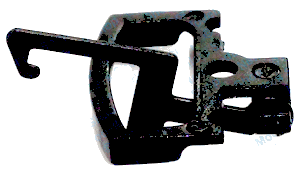
|
|
Ever since developed by
Tri-ang in the late 1950s, the tension lock
coupler has been the standard device used on
British 00 scale models. Consisting of a fixed
loop bar and a raisable "fish-hook",
they are foremost and above all designed to
perform automatic coupling. This is
achieved by pushing the hook through forward
motion over the loop of the next vehicule's
coupler; once the hook drops again, the two items
of rolling stock are securely coupled and, thanks
to the barbed form of the hook, interlocked - in
fact so much so that uncoupling becomes
a major problem, even when taking stock off the
rails.
|
|
| |
| In general,
tension lock couplers are therefore regarded as being
both unsightly and operations-unfriendly, and only
suffered because ready-to-run UK models offer no
alternative. |
| |
| As can be deduced by the way
a tension lock coupler works, uncoupling can only
be achieved by way of lifting the hook
sufficiently in order to allow the loop to pass
under it again - and this will only work when the
couplers are not under tension (hence their
name), i.e. the rolling stock is standing still. The
"classic" way of achieving this is by
using a sprung ramp between the rails. When a
train passes over it, the couplers are
interlocked through the tension and depress the
ramp. However, if the train stops, the ramp will
lift the now loose coupling hooks, splitting the
consist at this point.
The
problem is that this works fine most of the time
but not all of the time, and unwanted uncoupling
increases as the speed of a train passing over
the ramp decreases - as would of course be the
case on a shunting layout such as Little Bazeley.
The
answer to this problem is to have an uncoupling
ramp which is not permanently "active",
i.e. which is raised to push up the hooks only
when rolling stock standing over it is intended
to be uncoupled. A number of home-made systems,
ranging from basic to highly complex, have been
developed by numerous individuals, and there are
even commercially produced motorized solutions
which are push-button activated.
|
|
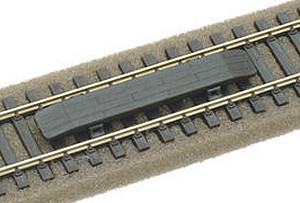
Peco uncoupling ramp (above), Gaugemaster
uncoupler (below)
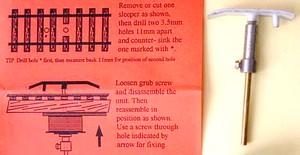
|
|
| |
| This allows
for remote uncoupling, but only at the exact location of
an uncoupling device, as tension lock couplers
immediately recouple once the hook is no longer raised,
making "delayed uncoupling" (i.e. pushing an
uncoupled wagon to a point beyond the uncoupling device)
impossible without modification to the couplers. This is one of the
major features and advantages of magnetic
uncoupling systems such as used by the well-known Kadee /
MicroTrains couplers, which (together with their much
sleeker appearance) accounts for their growing popularity
with UK prototype modellers. This is further heightened
by the now de facto standard of NEM 362 coupler
pockets on 00 scale models which allow for easy swapping
of couplers equipped with a swallow-tail end.
|
| |
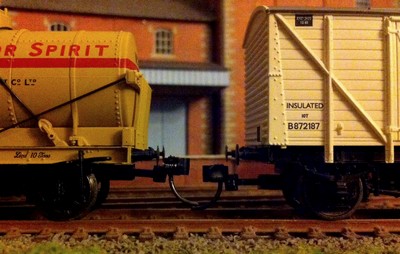
|
|
Unfortunately,
the NEM
362 specifications are mostly
adhered to by manufacturers with regard to the
pocket and coupler shafts but interpreted rather
loosely in terms of the distance to the railhead
(which NEM 362 sets out as 8.5mm with a tolerance
of +/- 0.2).
The negative effect this can
have on UK models fitted with Kadee couplers is
illustrated here: two pieces of rolling stock
from the same manufacturer (Bachmann UK) using
the very same NEM 362 Kadee couplers provide no
guarantee that the couplers will line up
correctly.
The different heights at
which the coupler pockets are located are clearly
visible in this random example.
|
|
| |
| This
results in a call for some major surgery in order to
achieve reliable uncoupling as Kadees (as well as other
magnetic buckeye couplers) tolerate little to no
misalignment in height between two couplers. But even if
all is well adjusted (and Kadee even produces a special
purpose vertical and lateral gauging tool to serve this
end), full reliability is not guaranteed. Again, uncoupling
is usually the bigger problem, leading to the strange
"Kadee dance" when a locomotive can be seen
pulling rolling stock back and forth over an uncoupling
magnet because the two couplings just won't separate.
This is why a growing number of modellers remove the trip
pins (which the magnets should force sideways) on their
Kadee couplers and prefer to uncouple them manually, thus
using the couplers only for the sake of better visual
appearance (examples are the BR Springburn Yard layout (there's a youtube video showing the pinless
Kadees during shunting moves) or the GWR/SR Hintock Branch 00
scale layout). |
| |
| One big advantage of the
Inglenook concept as operated on Little Bazeley
is that uncoupling moves only take place in one
direction (as all of the sidings point the same
way) and that the actual position of the freight
stock is of no importance as long as the maximum
number per siding is being respected and no
points are blocked. So,
it was back to the traditional tension lock
couplers for Little Bazeley as I really could not
be bothered with the major hassle of fitting and
adjusting Kadee couplers even on as few as the 8
cars necessary for the Inglenook operation (even
less so as Kadees are the most expensive option
by far) when reliable uncoupling was not assured.
|
|
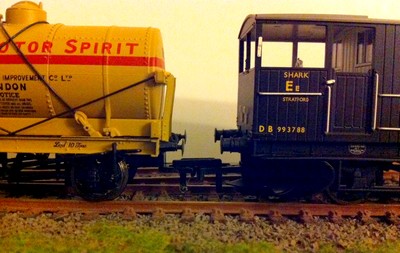
|
|
| |
| Kadees
require magnets for uncoupling, and there is an
alternative to the "activated uncoupling ramp"
approach for tension lock couplers which makes use of
magnets too. First described by Brian Kirby in December
2008 on rmweb.co.uk, this
method modifies the narrow Bachmann tension lock couplers
(which feature a coupling hook made of non-magnetic
material) by adding a bent iron staple to the hook. As
the rolling stock passes over a magnet, the hook is
pushed upwards as the staple is being drawn down by the
magnet. |
| |
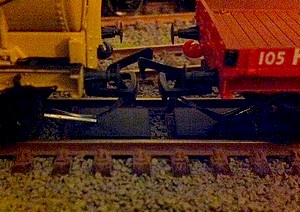 |
|
Putting the
concept to the test using rather coarse staple
samples (they are bent so that the inward leg
rises back against the wagon floor in
approximately a 45 degree angle) the setup worked
fairly reliably, especially when using fairly
large (i.e. thick) iron staples - finer examples
took more finetuning until they were attracted
downwards by one of the two magnets (one for each
coupler) between the track.
In comparison to any
self-made raisable uncoupling ramp (which can run
into unexpected re-alignment difficulties when
lowered back to in-between the tracks), the Kirby
method has the advantage of working faultlessly
once all the couplings are set up properly.
|
|
| |
| Just how
much time and effort one is prepared to invest in the
"setting up" of couplers and uncoupling devices
is a matter of taste and possibly also modelling skills.
Personally I found that adding the staples to the
counterarms of the coupling hooks took quite some time
and effort, yet reliable uncoupling on Little Bazeley
during extensive test runs was not assured. Whilst certainly due
to the flaws and shortcomings of the setup and not of the
method as such, I felt what I really wanted was an
uncoupling system which echoed the simplicity of the
layout itself. |
| |
| "Simple" and
"prototypical" usually don't go
together, but in this case I found that the way
shunting was performed on British Railways in the
1960s gave me the idea on how I was going to
uncouple rolling stock on Little Bazeley Sidings. Now
of course BR didn't use tension lock couplers.
But the main tool used when
working with hook-and-chain couplings was a shunting
pole which allowed the employee (called a shunter)
to reach between wagons to fasten and unfasten
couplings without having to physically place
himself between the rolling stock (and thus
reduced the risk of accidents). The shunter shown
in a 1950s BR in-house poster can be seen
carrying such a shunting pole in his right hand.
And
this is where Sid comes in.
Sid
is, of course, short for Sidney, the regular
shunter on runs to and from Little Bazeley
Sidings. But then Sid could also be seen as an
acronym for "simple device"
- for uncoupling, that is.
In
reality, Sid is a figure from a Preiser set of
track workers (#10418) and glued to a thin wire
with a 90 degrees hook at the end which
effectively acts as a shunting pole. I got the
basic - and ultra simple - idea of the hook from
a youtube video and
then simply added Sid as a slightly
tongue-in-cheek decoration. Just like the shunter
on the BR poster, he uses his pole to uncouple
rolling stock at Little Bazeley Sidings.
|
|
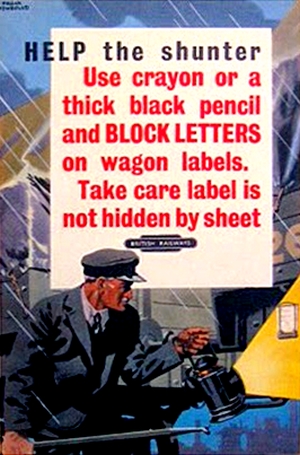
|
|
| |
| Most
uncoupling systems primarily try to avoid having the
infamous "big hand from the sky" appear. But
the "look no hands" approach has some very
noticeable flaws when used with tension lock couplers. No
matter whether it's the traditional sprung ramp or a
magnetic device that does the uncoupling, rolling stock
will always be uncoupled and remain at the very same spot
(i.e. where the uncoupling device is located). This is
because delayed uncoupling (where couplers are separated
and do not recouple if the wagons are pushed forward
after the uncoupling) is rather impractical with UK
tension lock couplers (although possible using a modified
Kirby system, as shown in this youtube video). The ultra simplistic
way of uncoupling tension lock couplers which Sid brings
to Little Bazeley seemed much better suited for a
shunting puzzle. The only modification to the original
youtube idea needed to ensure reliable uncoupling was to
remove the hooks from the couplers facing away from the
bufferstops at the sidings - this way, the hook only
needs to lift one single hook and instant re-coupling is
minimized (which I found to be a frequent occurence with
both hooks in place).
|
| |
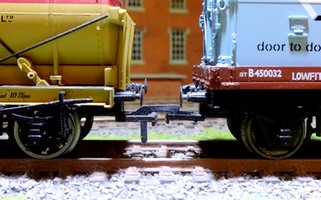 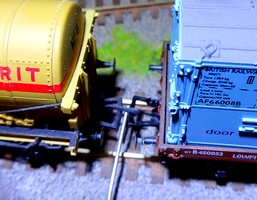 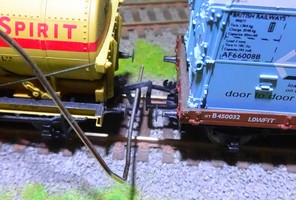 |
| |
Seen here is the single hook coupling
setup (left), the paperclip wire hook inserted between
the two loop bars (centre)
and finally the uncoupling of the two goods wagons by the
simple lifting action of the wire hook (right).
|
| |
 |
|
After initial tests I went
for something just a wee bit more elaborate - a
small 1.5mm Allen wrench which fits the purpose
just perfectly. Attaching Sid the shunter with
superglue really only serves cosmetic purposes... The big advantages of having
Sid do the uncoupling, basically, are:
a) no visually obtrusive
uncoupling devices,
b) only very minor modification of ready-to-run
stock required (removal of one single coupling
hook per wagon),
c) uncoupling is possible anywhere on the layout,
d) extremely cheap uncoupling system (as low as
the cost of a single paperclip if going for a
truly basic tool approach)
The major disadvantage for
many will, of course, be the big hand from the
sky involved in the uncoupling, but I have found
that ultimately this bothers me a lot less than a
hands-free magnetic uncoupling system which
doesn't work reliably.
|
|
 |
|
| |
| |
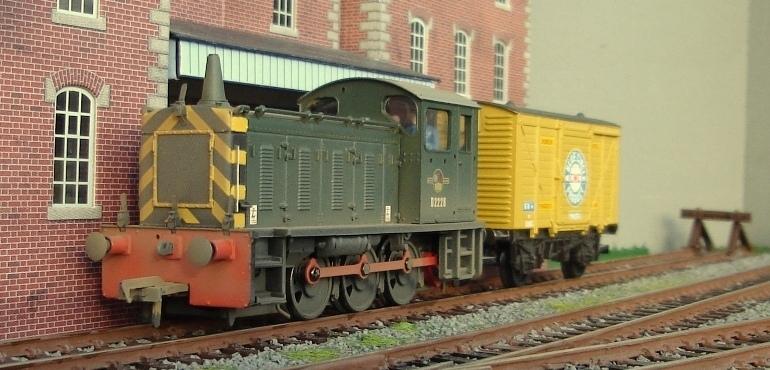
|
| |
|
| |
















